Ethical Dilemma at Buddy's Company
VerifiedAdded on 2020/03/16
|13
|4931
|38
AI Summary
This assignment presents a scenario where Buddy, an employee at a company, faces an ethical dilemma concerning his employer's actions. He must analyze the situation and propose potential solutions based on different ethical theories like utilitarianism, deontology, and virtue ethics. The task requires critical thinking, application of ethical frameworks, and justification of chosen solutions.
Contribute Materials
Your contribution can guide someone’s learning journey. Share your
documents today.
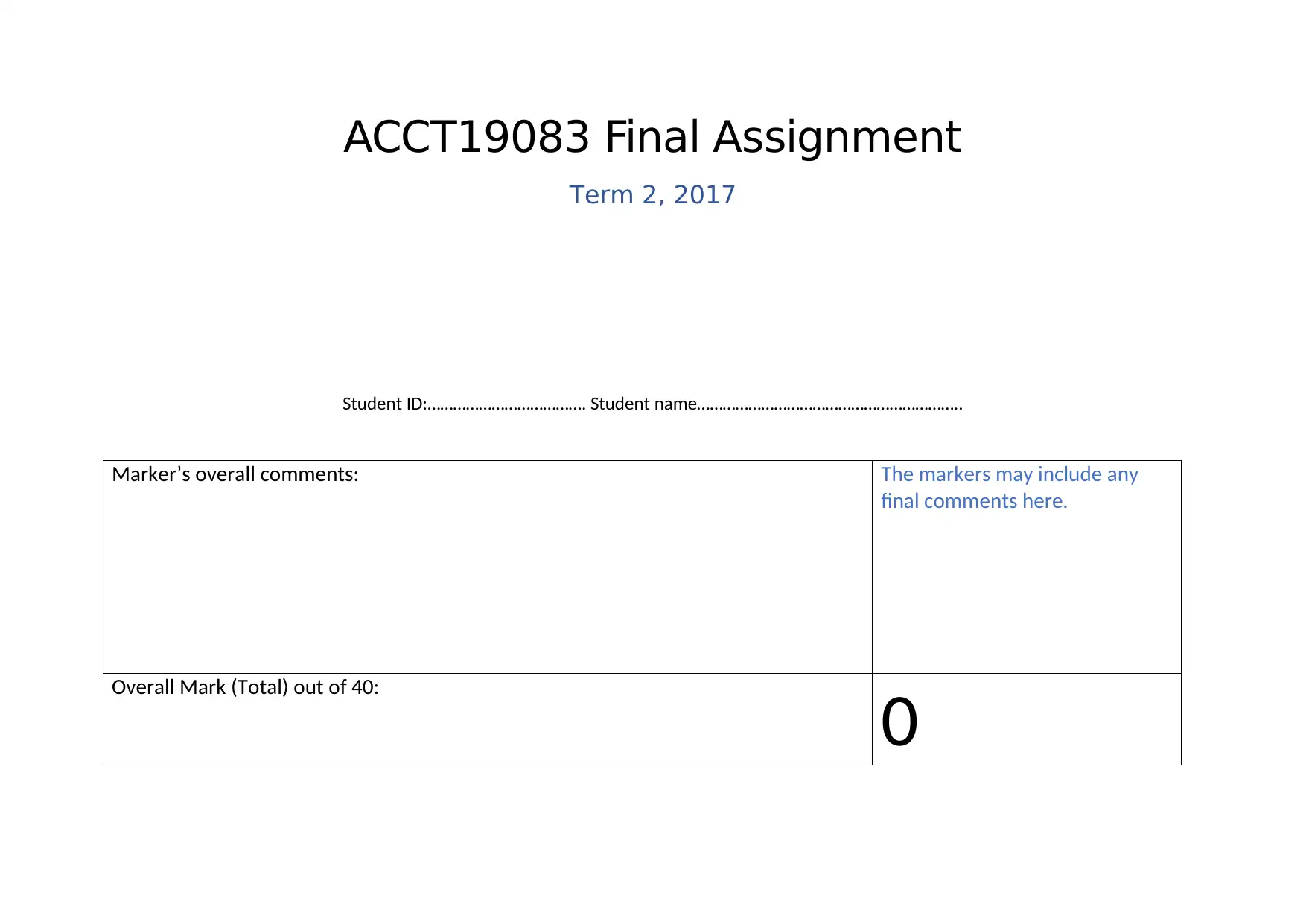
ACCT19083 Final Assignment
Term 2, 2017
Student ID:………………………………. Student name……………………………………………………..
Marker’s overall comments: The markers may include any
final comments here.
Overall Mark (Total) out of 40:
0
Term 2, 2017
Student ID:………………………………. Student name……………………………………………………..
Marker’s overall comments: The markers may include any
final comments here.
Overall Mark (Total) out of 40:
0
Secure Best Marks with AI Grader
Need help grading? Try our AI Grader for instant feedback on your assignments.

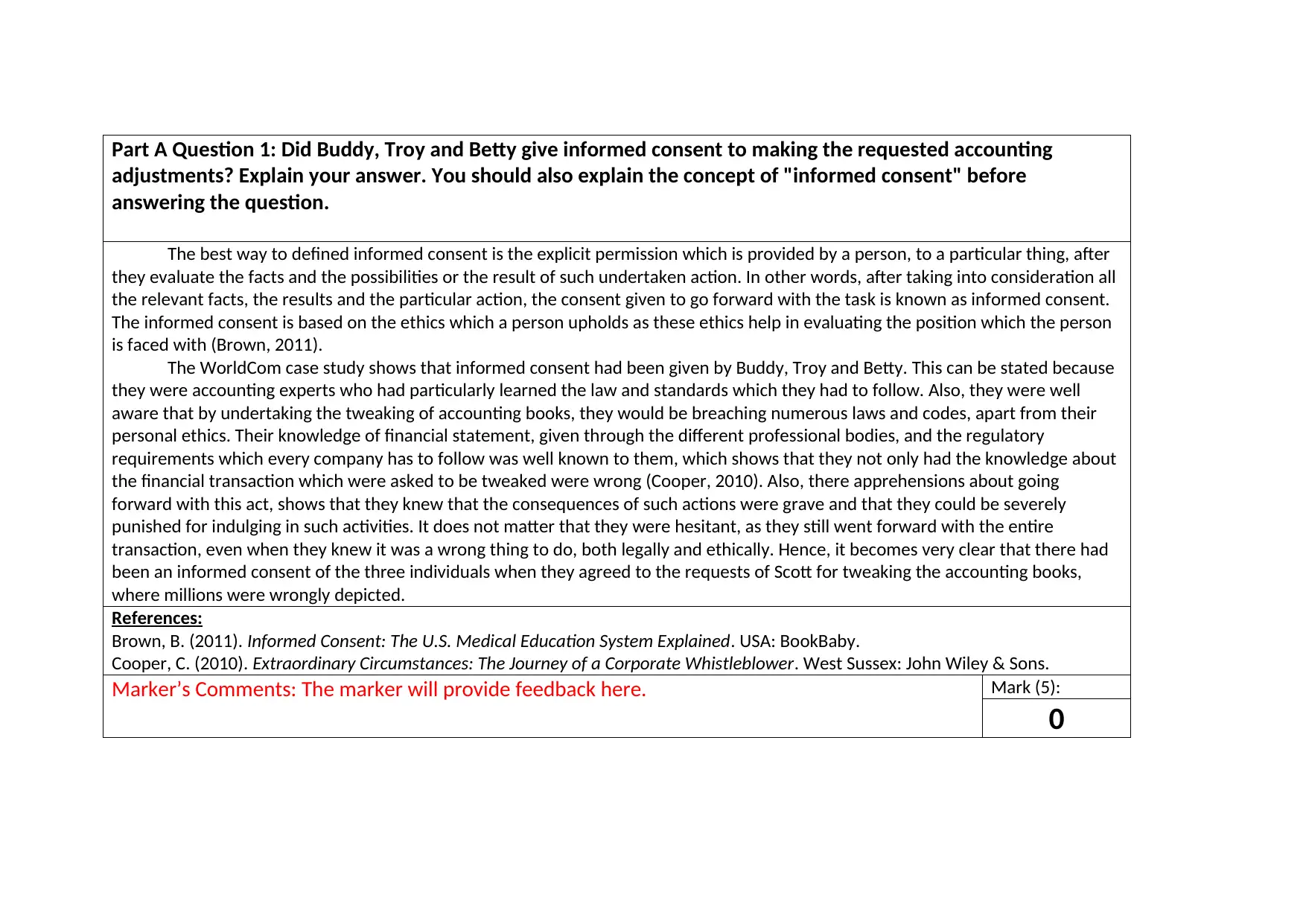
Part A Question 1: Did Buddy, Troy and Betty give informed consent to making the requested accounting
adjustments? Explain your answer. You should also explain the concept of "informed consent" before
answering the question.
The best way to defined informed consent is the explicit permission which is provided by a person, to a particular thing, after
they evaluate the facts and the possibilities or the result of such undertaken action. In other words, after taking into consideration all
the relevant facts, the results and the particular action, the consent given to go forward with the task is known as informed consent.
The informed consent is based on the ethics which a person upholds as these ethics help in evaluating the position which the person
is faced with (Brown, 2011).
The WorldCom case study shows that informed consent had been given by Buddy, Troy and Betty. This can be stated because
they were accounting experts who had particularly learned the law and standards which they had to follow. Also, they were well
aware that by undertaking the tweaking of accounting books, they would be breaching numerous laws and codes, apart from their
personal ethics. Their knowledge of financial statement, given through the different professional bodies, and the regulatory
requirements which every company has to follow was well known to them, which shows that they not only had the knowledge about
the financial transaction which were asked to be tweaked were wrong (Cooper, 2010). Also, there apprehensions about going
forward with this act, shows that they knew that the consequences of such actions were grave and that they could be severely
punished for indulging in such activities. It does not matter that they were hesitant, as they still went forward with the entire
transaction, even when they knew it was a wrong thing to do, both legally and ethically. Hence, it becomes very clear that there had
been an informed consent of the three individuals when they agreed to the requests of Scott for tweaking the accounting books,
where millions were wrongly depicted.
References:
Brown, B. (2011). Informed Consent: The U.S. Medical Education System Explained. USA: BookBaby.
Cooper, C. (2010). Extraordinary Circumstances: The Journey of a Corporate Whistleblower. West Sussex: John Wiley & Sons.
Marker’s Comments: The marker will provide feedback here. Mark (5):
0
adjustments? Explain your answer. You should also explain the concept of "informed consent" before
answering the question.
The best way to defined informed consent is the explicit permission which is provided by a person, to a particular thing, after
they evaluate the facts and the possibilities or the result of such undertaken action. In other words, after taking into consideration all
the relevant facts, the results and the particular action, the consent given to go forward with the task is known as informed consent.
The informed consent is based on the ethics which a person upholds as these ethics help in evaluating the position which the person
is faced with (Brown, 2011).
The WorldCom case study shows that informed consent had been given by Buddy, Troy and Betty. This can be stated because
they were accounting experts who had particularly learned the law and standards which they had to follow. Also, they were well
aware that by undertaking the tweaking of accounting books, they would be breaching numerous laws and codes, apart from their
personal ethics. Their knowledge of financial statement, given through the different professional bodies, and the regulatory
requirements which every company has to follow was well known to them, which shows that they not only had the knowledge about
the financial transaction which were asked to be tweaked were wrong (Cooper, 2010). Also, there apprehensions about going
forward with this act, shows that they knew that the consequences of such actions were grave and that they could be severely
punished for indulging in such activities. It does not matter that they were hesitant, as they still went forward with the entire
transaction, even when they knew it was a wrong thing to do, both legally and ethically. Hence, it becomes very clear that there had
been an informed consent of the three individuals when they agreed to the requests of Scott for tweaking the accounting books,
where millions were wrongly depicted.
References:
Brown, B. (2011). Informed Consent: The U.S. Medical Education System Explained. USA: BookBaby.
Cooper, C. (2010). Extraordinary Circumstances: The Journey of a Corporate Whistleblower. West Sussex: John Wiley & Sons.
Marker’s Comments: The marker will provide feedback here. Mark (5):
0
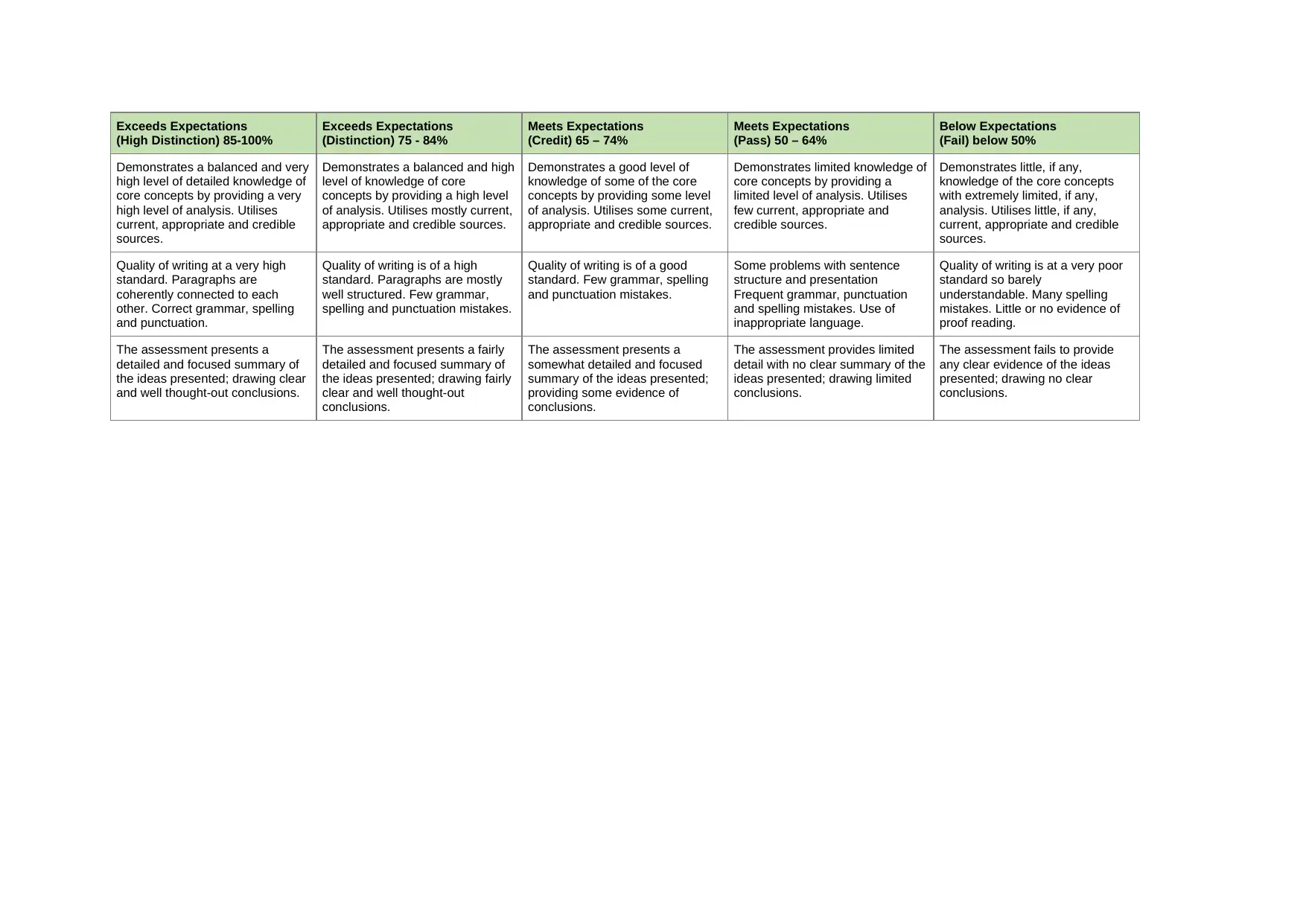
Exceeds Expectations
(High Distinction) 85-100%
Exceeds Expectations
(Distinction) 75 - 84%
Meets Expectations
(Credit) 65 – 74%
Meets Expectations
(Pass) 50 – 64%
Below Expectations
(Fail) below 50%
Demonstrates a balanced and very
high level of detailed knowledge of
core concepts by providing a very
high level of analysis. Utilises
current, appropriate and credible
sources.
Demonstrates a balanced and high
level of knowledge of core
concepts by providing a high level
of analysis. Utilises mostly current,
appropriate and credible sources.
Demonstrates a good level of
knowledge of some of the core
concepts by providing some level
of analysis. Utilises some current,
appropriate and credible sources.
Demonstrates limited knowledge of
core concepts by providing a
limited level of analysis. Utilises
few current, appropriate and
credible sources.
Demonstrates little, if any,
knowledge of the core concepts
with extremely limited, if any,
analysis. Utilises little, if any,
current, appropriate and credible
sources.
Quality of writing at a very high
standard. Paragraphs are
coherently connected to each
other. Correct grammar, spelling
and punctuation.
Quality of writing is of a high
standard. Paragraphs are mostly
well structured. Few grammar,
spelling and punctuation mistakes.
Quality of writing is of a good
standard. Few grammar, spelling
and punctuation mistakes.
Some problems with sentence
structure and presentation
Frequent grammar, punctuation
and spelling mistakes. Use of
inappropriate language.
Quality of writing is at a very poor
standard so barely
understandable. Many spelling
mistakes. Little or no evidence of
proof reading.
The assessment presents a
detailed and focused summary of
the ideas presented; drawing clear
and well thought-out conclusions.
The assessment presents a fairly
detailed and focused summary of
the ideas presented; drawing fairly
clear and well thought-out
conclusions.
The assessment presents a
somewhat detailed and focused
summary of the ideas presented;
providing some evidence of
conclusions.
The assessment provides limited
detail with no clear summary of the
ideas presented; drawing limited
conclusions.
The assessment fails to provide
any clear evidence of the ideas
presented; drawing no clear
conclusions.
(High Distinction) 85-100%
Exceeds Expectations
(Distinction) 75 - 84%
Meets Expectations
(Credit) 65 – 74%
Meets Expectations
(Pass) 50 – 64%
Below Expectations
(Fail) below 50%
Demonstrates a balanced and very
high level of detailed knowledge of
core concepts by providing a very
high level of analysis. Utilises
current, appropriate and credible
sources.
Demonstrates a balanced and high
level of knowledge of core
concepts by providing a high level
of analysis. Utilises mostly current,
appropriate and credible sources.
Demonstrates a good level of
knowledge of some of the core
concepts by providing some level
of analysis. Utilises some current,
appropriate and credible sources.
Demonstrates limited knowledge of
core concepts by providing a
limited level of analysis. Utilises
few current, appropriate and
credible sources.
Demonstrates little, if any,
knowledge of the core concepts
with extremely limited, if any,
analysis. Utilises little, if any,
current, appropriate and credible
sources.
Quality of writing at a very high
standard. Paragraphs are
coherently connected to each
other. Correct grammar, spelling
and punctuation.
Quality of writing is of a high
standard. Paragraphs are mostly
well structured. Few grammar,
spelling and punctuation mistakes.
Quality of writing is of a good
standard. Few grammar, spelling
and punctuation mistakes.
Some problems with sentence
structure and presentation
Frequent grammar, punctuation
and spelling mistakes. Use of
inappropriate language.
Quality of writing is at a very poor
standard so barely
understandable. Many spelling
mistakes. Little or no evidence of
proof reading.
The assessment presents a
detailed and focused summary of
the ideas presented; drawing clear
and well thought-out conclusions.
The assessment presents a fairly
detailed and focused summary of
the ideas presented; drawing fairly
clear and well thought-out
conclusions.
The assessment presents a
somewhat detailed and focused
summary of the ideas presented;
providing some evidence of
conclusions.
The assessment provides limited
detail with no clear summary of the
ideas presented; drawing limited
conclusions.
The assessment fails to provide
any clear evidence of the ideas
presented; drawing no clear
conclusions.
Secure Best Marks with AI Grader
Need help grading? Try our AI Grader for instant feedback on your assignments.
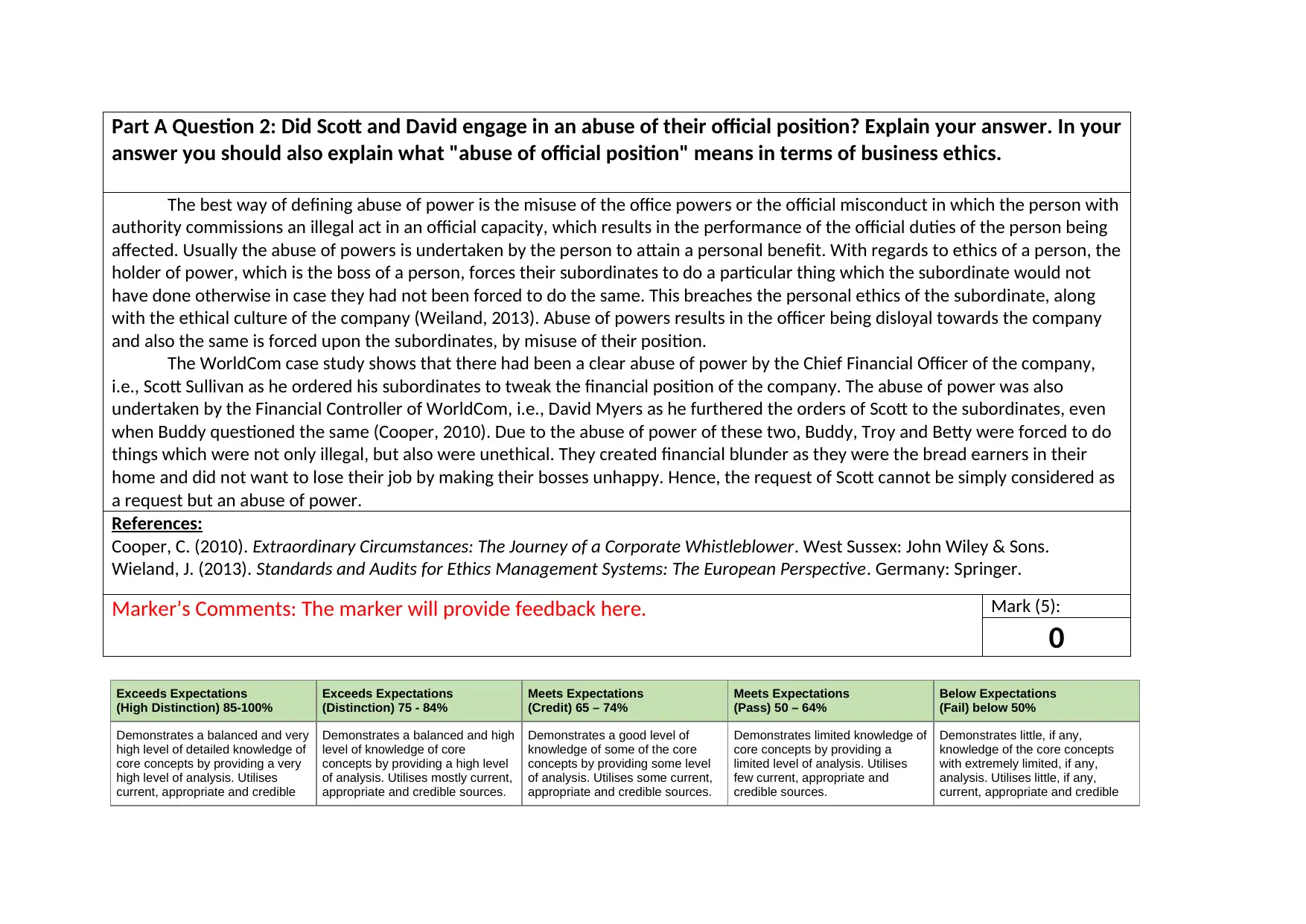
Part A Question 2: Did Scott and David engage in an abuse of their official position? Explain your answer. In your
answer you should also explain what "abuse of official position" means in terms of business ethics.
The best way of defining abuse of power is the misuse of the office powers or the official misconduct in which the person with
authority commissions an illegal act in an official capacity, which results in the performance of the official duties of the person being
affected. Usually the abuse of powers is undertaken by the person to attain a personal benefit. With regards to ethics of a person, the
holder of power, which is the boss of a person, forces their subordinates to do a particular thing which the subordinate would not
have done otherwise in case they had not been forced to do the same. This breaches the personal ethics of the subordinate, along
with the ethical culture of the company (Weiland, 2013). Abuse of powers results in the officer being disloyal towards the company
and also the same is forced upon the subordinates, by misuse of their position.
The WorldCom case study shows that there had been a clear abuse of power by the Chief Financial Officer of the company,
i.e., Scott Sullivan as he ordered his subordinates to tweak the financial position of the company. The abuse of power was also
undertaken by the Financial Controller of WorldCom, i.e., David Myers as he furthered the orders of Scott to the subordinates, even
when Buddy questioned the same (Cooper, 2010). Due to the abuse of power of these two, Buddy, Troy and Betty were forced to do
things which were not only illegal, but also were unethical. They created financial blunder as they were the bread earners in their
home and did not want to lose their job by making their bosses unhappy. Hence, the request of Scott cannot be simply considered as
a request but an abuse of power.
References:
Cooper, C. (2010). Extraordinary Circumstances: The Journey of a Corporate Whistleblower. West Sussex: John Wiley & Sons.
Wieland, J. (2013). Standards and Audits for Ethics Management Systems: The European Perspective. Germany: Springer.
Marker’s Comments: The marker will provide feedback here. Mark (5):
0
Exceeds Expectations
(High Distinction) 85-100%
Exceeds Expectations
(Distinction) 75 - 84%
Meets Expectations
(Credit) 65 – 74%
Meets Expectations
(Pass) 50 – 64%
Below Expectations
(Fail) below 50%
Demonstrates a balanced and very
high level of detailed knowledge of
core concepts by providing a very
high level of analysis. Utilises
current, appropriate and credible
Demonstrates a balanced and high
level of knowledge of core
concepts by providing a high level
of analysis. Utilises mostly current,
appropriate and credible sources.
Demonstrates a good level of
knowledge of some of the core
concepts by providing some level
of analysis. Utilises some current,
appropriate and credible sources.
Demonstrates limited knowledge of
core concepts by providing a
limited level of analysis. Utilises
few current, appropriate and
credible sources.
Demonstrates little, if any,
knowledge of the core concepts
with extremely limited, if any,
analysis. Utilises little, if any,
current, appropriate and credible
answer you should also explain what "abuse of official position" means in terms of business ethics.
The best way of defining abuse of power is the misuse of the office powers or the official misconduct in which the person with
authority commissions an illegal act in an official capacity, which results in the performance of the official duties of the person being
affected. Usually the abuse of powers is undertaken by the person to attain a personal benefit. With regards to ethics of a person, the
holder of power, which is the boss of a person, forces their subordinates to do a particular thing which the subordinate would not
have done otherwise in case they had not been forced to do the same. This breaches the personal ethics of the subordinate, along
with the ethical culture of the company (Weiland, 2013). Abuse of powers results in the officer being disloyal towards the company
and also the same is forced upon the subordinates, by misuse of their position.
The WorldCom case study shows that there had been a clear abuse of power by the Chief Financial Officer of the company,
i.e., Scott Sullivan as he ordered his subordinates to tweak the financial position of the company. The abuse of power was also
undertaken by the Financial Controller of WorldCom, i.e., David Myers as he furthered the orders of Scott to the subordinates, even
when Buddy questioned the same (Cooper, 2010). Due to the abuse of power of these two, Buddy, Troy and Betty were forced to do
things which were not only illegal, but also were unethical. They created financial blunder as they were the bread earners in their
home and did not want to lose their job by making their bosses unhappy. Hence, the request of Scott cannot be simply considered as
a request but an abuse of power.
References:
Cooper, C. (2010). Extraordinary Circumstances: The Journey of a Corporate Whistleblower. West Sussex: John Wiley & Sons.
Wieland, J. (2013). Standards and Audits for Ethics Management Systems: The European Perspective. Germany: Springer.
Marker’s Comments: The marker will provide feedback here. Mark (5):
0
Exceeds Expectations
(High Distinction) 85-100%
Exceeds Expectations
(Distinction) 75 - 84%
Meets Expectations
(Credit) 65 – 74%
Meets Expectations
(Pass) 50 – 64%
Below Expectations
(Fail) below 50%
Demonstrates a balanced and very
high level of detailed knowledge of
core concepts by providing a very
high level of analysis. Utilises
current, appropriate and credible
Demonstrates a balanced and high
level of knowledge of core
concepts by providing a high level
of analysis. Utilises mostly current,
appropriate and credible sources.
Demonstrates a good level of
knowledge of some of the core
concepts by providing some level
of analysis. Utilises some current,
appropriate and credible sources.
Demonstrates limited knowledge of
core concepts by providing a
limited level of analysis. Utilises
few current, appropriate and
credible sources.
Demonstrates little, if any,
knowledge of the core concepts
with extremely limited, if any,
analysis. Utilises little, if any,
current, appropriate and credible
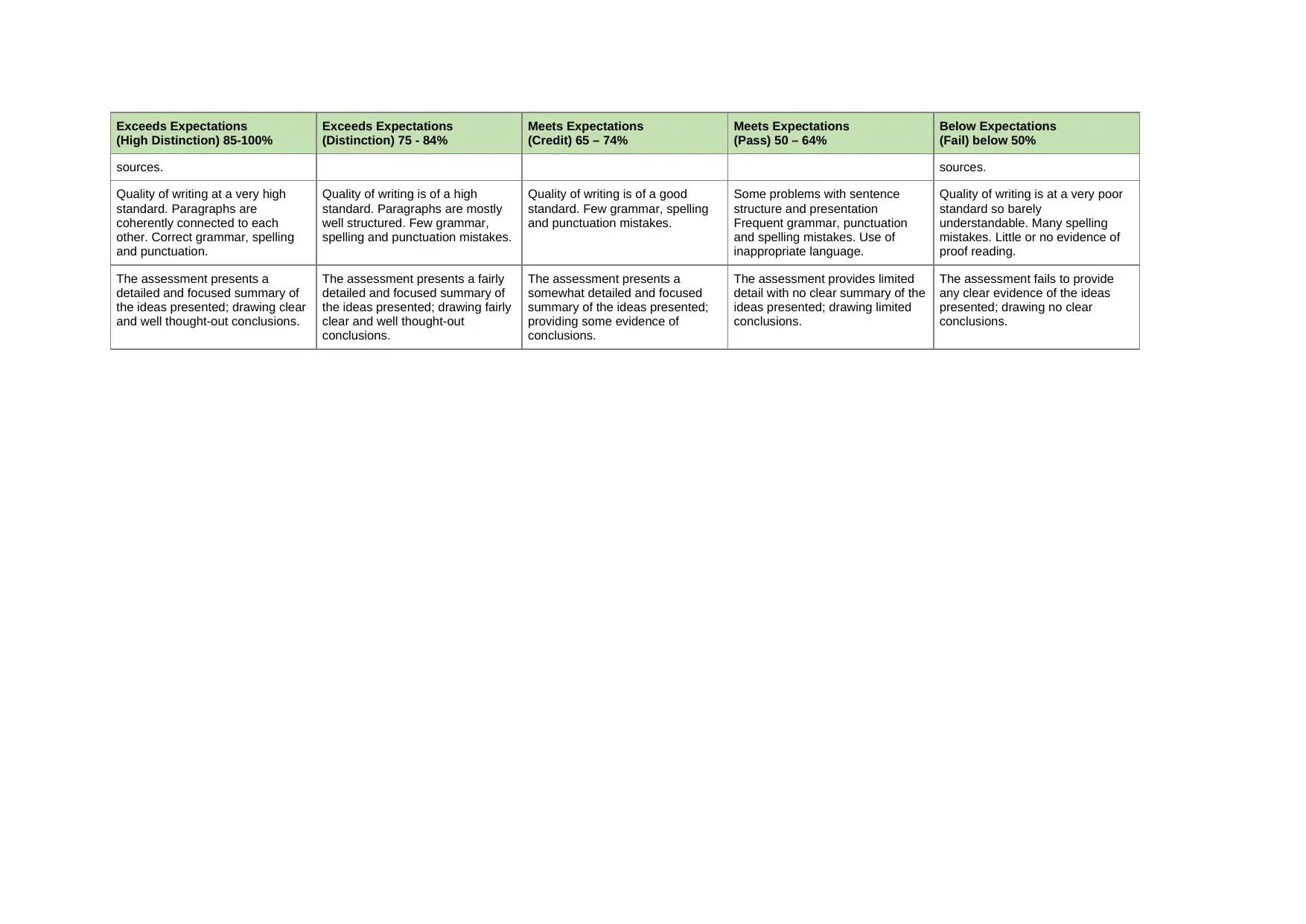
Exceeds Expectations
(High Distinction) 85-100%
Exceeds Expectations
(Distinction) 75 - 84%
Meets Expectations
(Credit) 65 – 74%
Meets Expectations
(Pass) 50 – 64%
Below Expectations
(Fail) below 50%
sources. sources.
Quality of writing at a very high
standard. Paragraphs are
coherently connected to each
other. Correct grammar, spelling
and punctuation.
Quality of writing is of a high
standard. Paragraphs are mostly
well structured. Few grammar,
spelling and punctuation mistakes.
Quality of writing is of a good
standard. Few grammar, spelling
and punctuation mistakes.
Some problems with sentence
structure and presentation
Frequent grammar, punctuation
and spelling mistakes. Use of
inappropriate language.
Quality of writing is at a very poor
standard so barely
understandable. Many spelling
mistakes. Little or no evidence of
proof reading.
The assessment presents a
detailed and focused summary of
the ideas presented; drawing clear
and well thought-out conclusions.
The assessment presents a fairly
detailed and focused summary of
the ideas presented; drawing fairly
clear and well thought-out
conclusions.
The assessment presents a
somewhat detailed and focused
summary of the ideas presented;
providing some evidence of
conclusions.
The assessment provides limited
detail with no clear summary of the
ideas presented; drawing limited
conclusions.
The assessment fails to provide
any clear evidence of the ideas
presented; drawing no clear
conclusions.
(High Distinction) 85-100%
Exceeds Expectations
(Distinction) 75 - 84%
Meets Expectations
(Credit) 65 – 74%
Meets Expectations
(Pass) 50 – 64%
Below Expectations
(Fail) below 50%
sources. sources.
Quality of writing at a very high
standard. Paragraphs are
coherently connected to each
other. Correct grammar, spelling
and punctuation.
Quality of writing is of a high
standard. Paragraphs are mostly
well structured. Few grammar,
spelling and punctuation mistakes.
Quality of writing is of a good
standard. Few grammar, spelling
and punctuation mistakes.
Some problems with sentence
structure and presentation
Frequent grammar, punctuation
and spelling mistakes. Use of
inappropriate language.
Quality of writing is at a very poor
standard so barely
understandable. Many spelling
mistakes. Little or no evidence of
proof reading.
The assessment presents a
detailed and focused summary of
the ideas presented; drawing clear
and well thought-out conclusions.
The assessment presents a fairly
detailed and focused summary of
the ideas presented; drawing fairly
clear and well thought-out
conclusions.
The assessment presents a
somewhat detailed and focused
summary of the ideas presented;
providing some evidence of
conclusions.
The assessment provides limited
detail with no clear summary of the
ideas presented; drawing limited
conclusions.
The assessment fails to provide
any clear evidence of the ideas
presented; drawing no clear
conclusions.
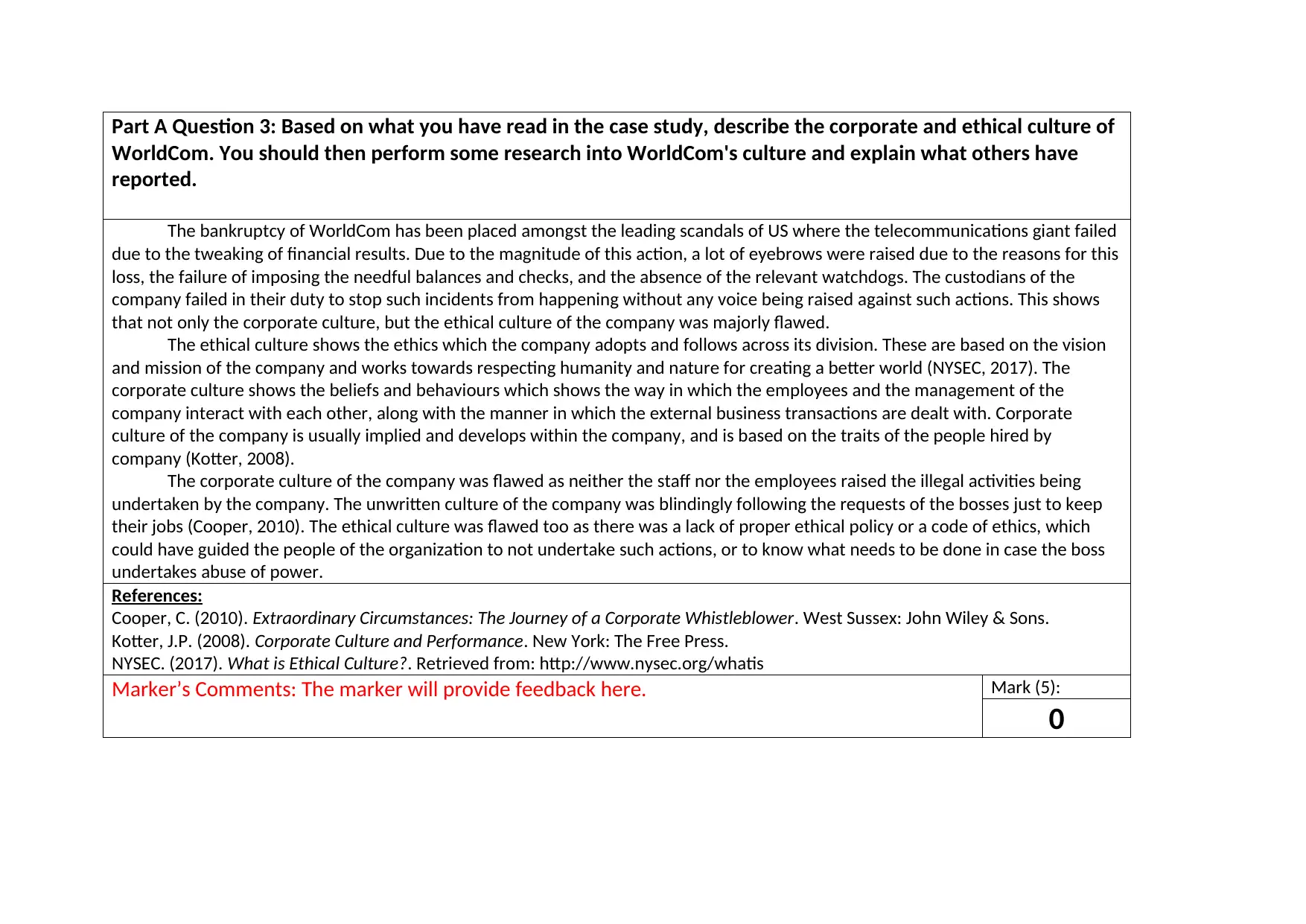
Part A Question 3: Based on what you have read in the case study, describe the corporate and ethical culture of
WorldCom. You should then perform some research into WorldCom's culture and explain what others have
reported.
The bankruptcy of WorldCom has been placed amongst the leading scandals of US where the telecommunications giant failed
due to the tweaking of financial results. Due to the magnitude of this action, a lot of eyebrows were raised due to the reasons for this
loss, the failure of imposing the needful balances and checks, and the absence of the relevant watchdogs. The custodians of the
company failed in their duty to stop such incidents from happening without any voice being raised against such actions. This shows
that not only the corporate culture, but the ethical culture of the company was majorly flawed.
The ethical culture shows the ethics which the company adopts and follows across its division. These are based on the vision
and mission of the company and works towards respecting humanity and nature for creating a better world (NYSEC, 2017). The
corporate culture shows the beliefs and behaviours which shows the way in which the employees and the management of the
company interact with each other, along with the manner in which the external business transactions are dealt with. Corporate
culture of the company is usually implied and develops within the company, and is based on the traits of the people hired by
company (Kotter, 2008).
The corporate culture of the company was flawed as neither the staff nor the employees raised the illegal activities being
undertaken by the company. The unwritten culture of the company was blindingly following the requests of the bosses just to keep
their jobs (Cooper, 2010). The ethical culture was flawed too as there was a lack of proper ethical policy or a code of ethics, which
could have guided the people of the organization to not undertake such actions, or to know what needs to be done in case the boss
undertakes abuse of power.
References:
Cooper, C. (2010). Extraordinary Circumstances: The Journey of a Corporate Whistleblower. West Sussex: John Wiley & Sons.
Kotter, J.P. (2008). Corporate Culture and Performance. New York: The Free Press.
NYSEC. (2017). What is Ethical Culture?. Retrieved from: http://www.nysec.org/whatis
Marker’s Comments: The marker will provide feedback here. Mark (5):
0
WorldCom. You should then perform some research into WorldCom's culture and explain what others have
reported.
The bankruptcy of WorldCom has been placed amongst the leading scandals of US where the telecommunications giant failed
due to the tweaking of financial results. Due to the magnitude of this action, a lot of eyebrows were raised due to the reasons for this
loss, the failure of imposing the needful balances and checks, and the absence of the relevant watchdogs. The custodians of the
company failed in their duty to stop such incidents from happening without any voice being raised against such actions. This shows
that not only the corporate culture, but the ethical culture of the company was majorly flawed.
The ethical culture shows the ethics which the company adopts and follows across its division. These are based on the vision
and mission of the company and works towards respecting humanity and nature for creating a better world (NYSEC, 2017). The
corporate culture shows the beliefs and behaviours which shows the way in which the employees and the management of the
company interact with each other, along with the manner in which the external business transactions are dealt with. Corporate
culture of the company is usually implied and develops within the company, and is based on the traits of the people hired by
company (Kotter, 2008).
The corporate culture of the company was flawed as neither the staff nor the employees raised the illegal activities being
undertaken by the company. The unwritten culture of the company was blindingly following the requests of the bosses just to keep
their jobs (Cooper, 2010). The ethical culture was flawed too as there was a lack of proper ethical policy or a code of ethics, which
could have guided the people of the organization to not undertake such actions, or to know what needs to be done in case the boss
undertakes abuse of power.
References:
Cooper, C. (2010). Extraordinary Circumstances: The Journey of a Corporate Whistleblower. West Sussex: John Wiley & Sons.
Kotter, J.P. (2008). Corporate Culture and Performance. New York: The Free Press.
NYSEC. (2017). What is Ethical Culture?. Retrieved from: http://www.nysec.org/whatis
Marker’s Comments: The marker will provide feedback here. Mark (5):
0
Paraphrase This Document
Need a fresh take? Get an instant paraphrase of this document with our AI Paraphraser
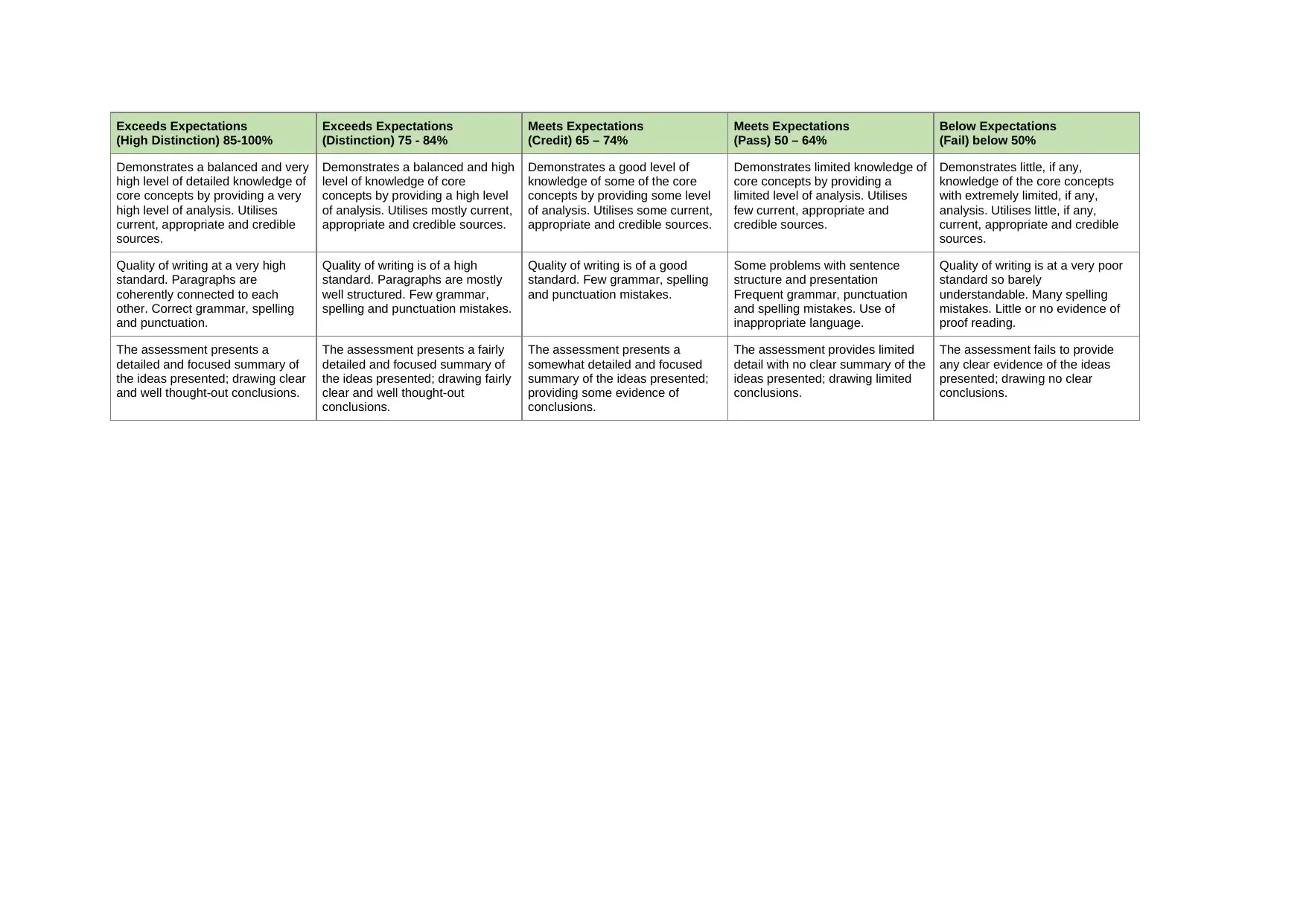
Exceeds Expectations
(High Distinction) 85-100%
Exceeds Expectations
(Distinction) 75 - 84%
Meets Expectations
(Credit) 65 – 74%
Meets Expectations
(Pass) 50 – 64%
Below Expectations
(Fail) below 50%
Demonstrates a balanced and very
high level of detailed knowledge of
core concepts by providing a very
high level of analysis. Utilises
current, appropriate and credible
sources.
Demonstrates a balanced and high
level of knowledge of core
concepts by providing a high level
of analysis. Utilises mostly current,
appropriate and credible sources.
Demonstrates a good level of
knowledge of some of the core
concepts by providing some level
of analysis. Utilises some current,
appropriate and credible sources.
Demonstrates limited knowledge of
core concepts by providing a
limited level of analysis. Utilises
few current, appropriate and
credible sources.
Demonstrates little, if any,
knowledge of the core concepts
with extremely limited, if any,
analysis. Utilises little, if any,
current, appropriate and credible
sources.
Quality of writing at a very high
standard. Paragraphs are
coherently connected to each
other. Correct grammar, spelling
and punctuation.
Quality of writing is of a high
standard. Paragraphs are mostly
well structured. Few grammar,
spelling and punctuation mistakes.
Quality of writing is of a good
standard. Few grammar, spelling
and punctuation mistakes.
Some problems with sentence
structure and presentation
Frequent grammar, punctuation
and spelling mistakes. Use of
inappropriate language.
Quality of writing is at a very poor
standard so barely
understandable. Many spelling
mistakes. Little or no evidence of
proof reading.
The assessment presents a
detailed and focused summary of
the ideas presented; drawing clear
and well thought-out conclusions.
The assessment presents a fairly
detailed and focused summary of
the ideas presented; drawing fairly
clear and well thought-out
conclusions.
The assessment presents a
somewhat detailed and focused
summary of the ideas presented;
providing some evidence of
conclusions.
The assessment provides limited
detail with no clear summary of the
ideas presented; drawing limited
conclusions.
The assessment fails to provide
any clear evidence of the ideas
presented; drawing no clear
conclusions.
(High Distinction) 85-100%
Exceeds Expectations
(Distinction) 75 - 84%
Meets Expectations
(Credit) 65 – 74%
Meets Expectations
(Pass) 50 – 64%
Below Expectations
(Fail) below 50%
Demonstrates a balanced and very
high level of detailed knowledge of
core concepts by providing a very
high level of analysis. Utilises
current, appropriate and credible
sources.
Demonstrates a balanced and high
level of knowledge of core
concepts by providing a high level
of analysis. Utilises mostly current,
appropriate and credible sources.
Demonstrates a good level of
knowledge of some of the core
concepts by providing some level
of analysis. Utilises some current,
appropriate and credible sources.
Demonstrates limited knowledge of
core concepts by providing a
limited level of analysis. Utilises
few current, appropriate and
credible sources.
Demonstrates little, if any,
knowledge of the core concepts
with extremely limited, if any,
analysis. Utilises little, if any,
current, appropriate and credible
sources.
Quality of writing at a very high
standard. Paragraphs are
coherently connected to each
other. Correct grammar, spelling
and punctuation.
Quality of writing is of a high
standard. Paragraphs are mostly
well structured. Few grammar,
spelling and punctuation mistakes.
Quality of writing is of a good
standard. Few grammar, spelling
and punctuation mistakes.
Some problems with sentence
structure and presentation
Frequent grammar, punctuation
and spelling mistakes. Use of
inappropriate language.
Quality of writing is at a very poor
standard so barely
understandable. Many spelling
mistakes. Little or no evidence of
proof reading.
The assessment presents a
detailed and focused summary of
the ideas presented; drawing clear
and well thought-out conclusions.
The assessment presents a fairly
detailed and focused summary of
the ideas presented; drawing fairly
clear and well thought-out
conclusions.
The assessment presents a
somewhat detailed and focused
summary of the ideas presented;
providing some evidence of
conclusions.
The assessment provides limited
detail with no clear summary of the
ideas presented; drawing limited
conclusions.
The assessment fails to provide
any clear evidence of the ideas
presented; drawing no clear
conclusions.
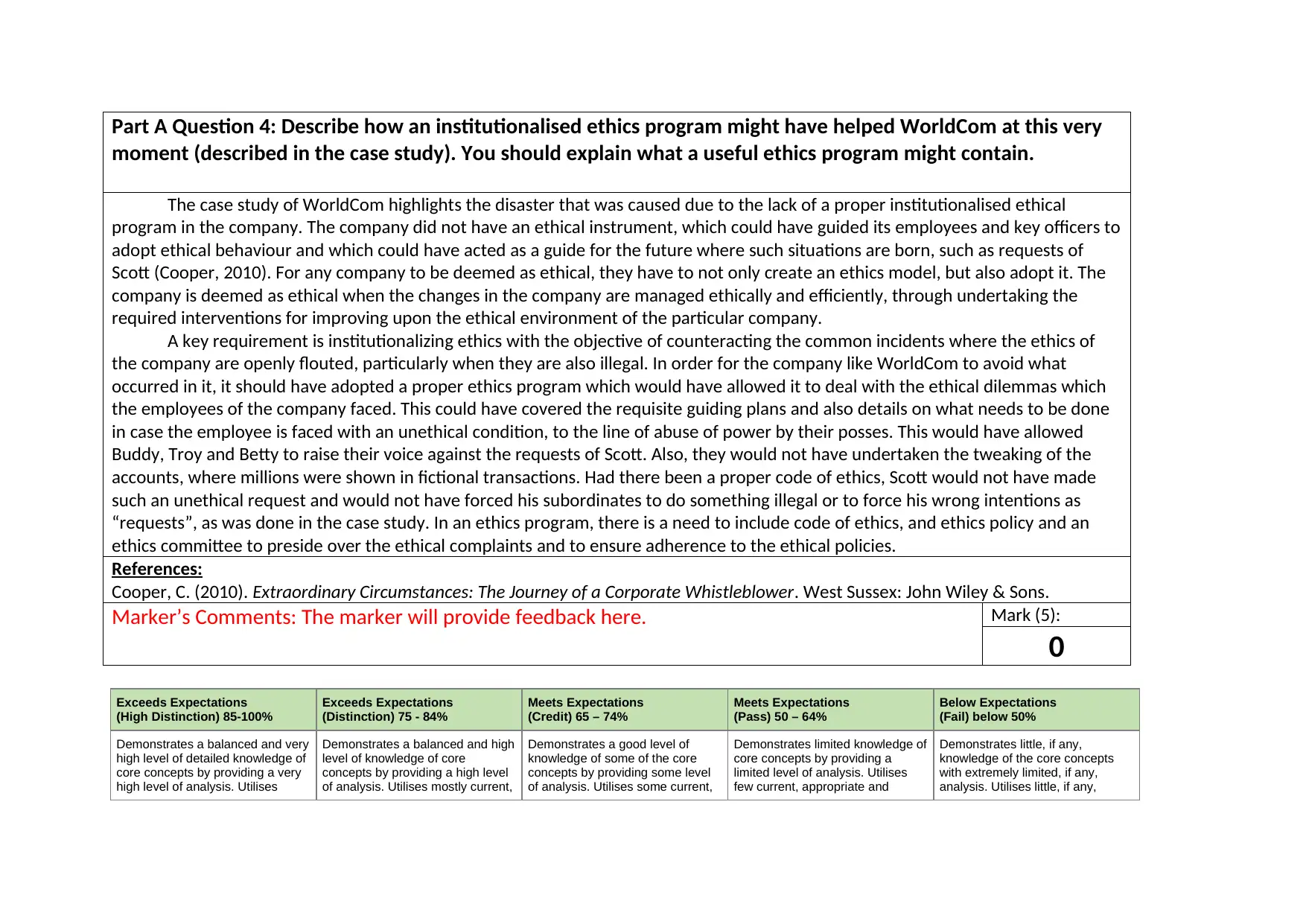
Part A Question 4: Describe how an institutionalised ethics program might have helped WorldCom at this very
moment (described in the case study). You should explain what a useful ethics program might contain.
The case study of WorldCom highlights the disaster that was caused due to the lack of a proper institutionalised ethical
program in the company. The company did not have an ethical instrument, which could have guided its employees and key officers to
adopt ethical behaviour and which could have acted as a guide for the future where such situations are born, such as requests of
Scott (Cooper, 2010). For any company to be deemed as ethical, they have to not only create an ethics model, but also adopt it. The
company is deemed as ethical when the changes in the company are managed ethically and efficiently, through undertaking the
required interventions for improving upon the ethical environment of the particular company.
A key requirement is institutionalizing ethics with the objective of counteracting the common incidents where the ethics of
the company are openly flouted, particularly when they are also illegal. In order for the company like WorldCom to avoid what
occurred in it, it should have adopted a proper ethics program which would have allowed it to deal with the ethical dilemmas which
the employees of the company faced. This could have covered the requisite guiding plans and also details on what needs to be done
in case the employee is faced with an unethical condition, to the line of abuse of power by their posses. This would have allowed
Buddy, Troy and Betty to raise their voice against the requests of Scott. Also, they would not have undertaken the tweaking of the
accounts, where millions were shown in fictional transactions. Had there been a proper code of ethics, Scott would not have made
such an unethical request and would not have forced his subordinates to do something illegal or to force his wrong intentions as
“requests”, as was done in the case study. In an ethics program, there is a need to include code of ethics, and ethics policy and an
ethics committee to preside over the ethical complaints and to ensure adherence to the ethical policies.
References:
Cooper, C. (2010). Extraordinary Circumstances: The Journey of a Corporate Whistleblower. West Sussex: John Wiley & Sons.
Marker’s Comments: The marker will provide feedback here. Mark (5):
0
Exceeds Expectations
(High Distinction) 85-100%
Exceeds Expectations
(Distinction) 75 - 84%
Meets Expectations
(Credit) 65 – 74%
Meets Expectations
(Pass) 50 – 64%
Below Expectations
(Fail) below 50%
Demonstrates a balanced and very
high level of detailed knowledge of
core concepts by providing a very
high level of analysis. Utilises
Demonstrates a balanced and high
level of knowledge of core
concepts by providing a high level
of analysis. Utilises mostly current,
Demonstrates a good level of
knowledge of some of the core
concepts by providing some level
of analysis. Utilises some current,
Demonstrates limited knowledge of
core concepts by providing a
limited level of analysis. Utilises
few current, appropriate and
Demonstrates little, if any,
knowledge of the core concepts
with extremely limited, if any,
analysis. Utilises little, if any,
moment (described in the case study). You should explain what a useful ethics program might contain.
The case study of WorldCom highlights the disaster that was caused due to the lack of a proper institutionalised ethical
program in the company. The company did not have an ethical instrument, which could have guided its employees and key officers to
adopt ethical behaviour and which could have acted as a guide for the future where such situations are born, such as requests of
Scott (Cooper, 2010). For any company to be deemed as ethical, they have to not only create an ethics model, but also adopt it. The
company is deemed as ethical when the changes in the company are managed ethically and efficiently, through undertaking the
required interventions for improving upon the ethical environment of the particular company.
A key requirement is institutionalizing ethics with the objective of counteracting the common incidents where the ethics of
the company are openly flouted, particularly when they are also illegal. In order for the company like WorldCom to avoid what
occurred in it, it should have adopted a proper ethics program which would have allowed it to deal with the ethical dilemmas which
the employees of the company faced. This could have covered the requisite guiding plans and also details on what needs to be done
in case the employee is faced with an unethical condition, to the line of abuse of power by their posses. This would have allowed
Buddy, Troy and Betty to raise their voice against the requests of Scott. Also, they would not have undertaken the tweaking of the
accounts, where millions were shown in fictional transactions. Had there been a proper code of ethics, Scott would not have made
such an unethical request and would not have forced his subordinates to do something illegal or to force his wrong intentions as
“requests”, as was done in the case study. In an ethics program, there is a need to include code of ethics, and ethics policy and an
ethics committee to preside over the ethical complaints and to ensure adherence to the ethical policies.
References:
Cooper, C. (2010). Extraordinary Circumstances: The Journey of a Corporate Whistleblower. West Sussex: John Wiley & Sons.
Marker’s Comments: The marker will provide feedback here. Mark (5):
0
Exceeds Expectations
(High Distinction) 85-100%
Exceeds Expectations
(Distinction) 75 - 84%
Meets Expectations
(Credit) 65 – 74%
Meets Expectations
(Pass) 50 – 64%
Below Expectations
(Fail) below 50%
Demonstrates a balanced and very
high level of detailed knowledge of
core concepts by providing a very
high level of analysis. Utilises
Demonstrates a balanced and high
level of knowledge of core
concepts by providing a high level
of analysis. Utilises mostly current,
Demonstrates a good level of
knowledge of some of the core
concepts by providing some level
of analysis. Utilises some current,
Demonstrates limited knowledge of
core concepts by providing a
limited level of analysis. Utilises
few current, appropriate and
Demonstrates little, if any,
knowledge of the core concepts
with extremely limited, if any,
analysis. Utilises little, if any,
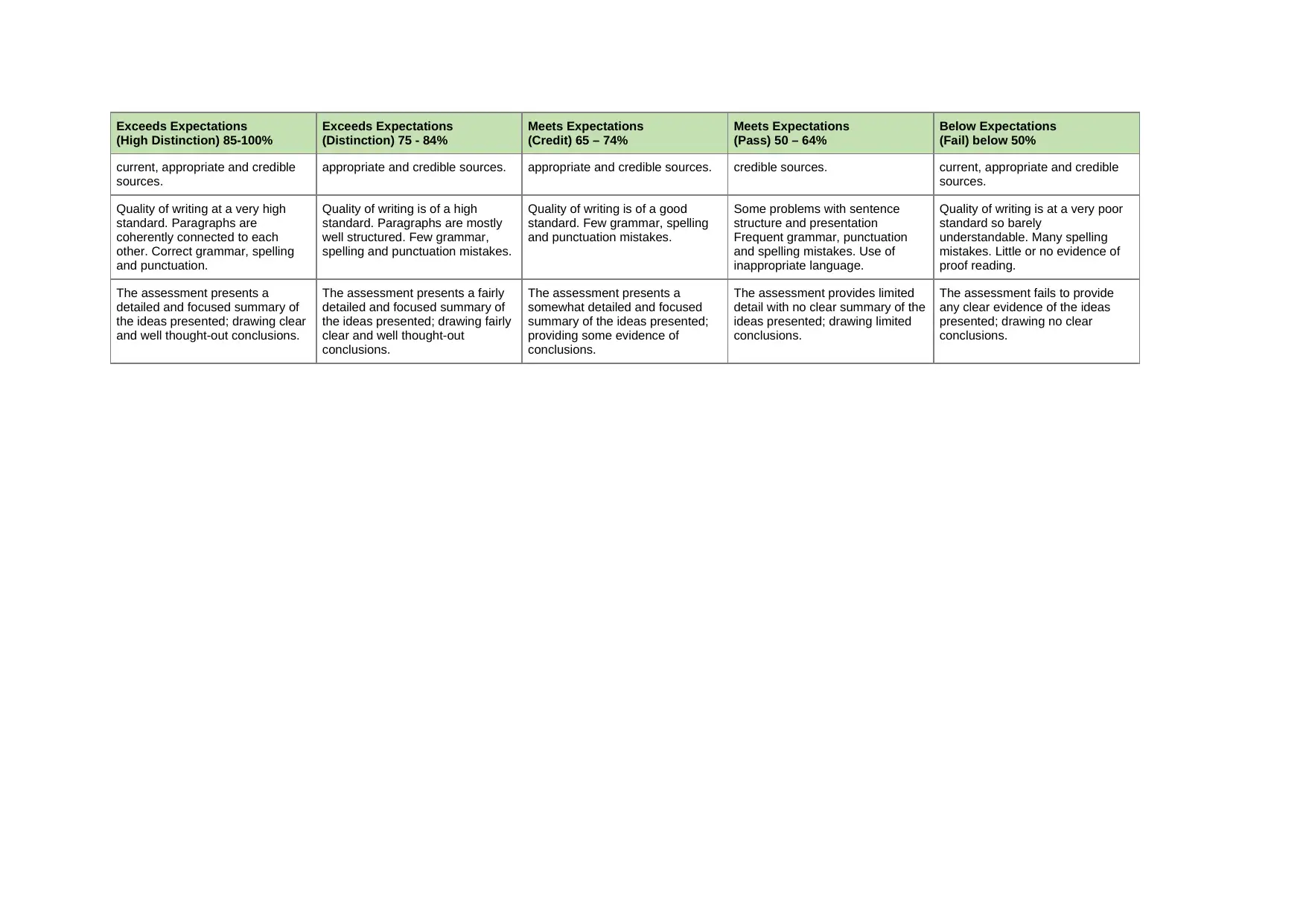
Exceeds Expectations
(High Distinction) 85-100%
Exceeds Expectations
(Distinction) 75 - 84%
Meets Expectations
(Credit) 65 – 74%
Meets Expectations
(Pass) 50 – 64%
Below Expectations
(Fail) below 50%
current, appropriate and credible
sources.
appropriate and credible sources. appropriate and credible sources. credible sources. current, appropriate and credible
sources.
Quality of writing at a very high
standard. Paragraphs are
coherently connected to each
other. Correct grammar, spelling
and punctuation.
Quality of writing is of a high
standard. Paragraphs are mostly
well structured. Few grammar,
spelling and punctuation mistakes.
Quality of writing is of a good
standard. Few grammar, spelling
and punctuation mistakes.
Some problems with sentence
structure and presentation
Frequent grammar, punctuation
and spelling mistakes. Use of
inappropriate language.
Quality of writing is at a very poor
standard so barely
understandable. Many spelling
mistakes. Little or no evidence of
proof reading.
The assessment presents a
detailed and focused summary of
the ideas presented; drawing clear
and well thought-out conclusions.
The assessment presents a fairly
detailed and focused summary of
the ideas presented; drawing fairly
clear and well thought-out
conclusions.
The assessment presents a
somewhat detailed and focused
summary of the ideas presented;
providing some evidence of
conclusions.
The assessment provides limited
detail with no clear summary of the
ideas presented; drawing limited
conclusions.
The assessment fails to provide
any clear evidence of the ideas
presented; drawing no clear
conclusions.
(High Distinction) 85-100%
Exceeds Expectations
(Distinction) 75 - 84%
Meets Expectations
(Credit) 65 – 74%
Meets Expectations
(Pass) 50 – 64%
Below Expectations
(Fail) below 50%
current, appropriate and credible
sources.
appropriate and credible sources. appropriate and credible sources. credible sources. current, appropriate and credible
sources.
Quality of writing at a very high
standard. Paragraphs are
coherently connected to each
other. Correct grammar, spelling
and punctuation.
Quality of writing is of a high
standard. Paragraphs are mostly
well structured. Few grammar,
spelling and punctuation mistakes.
Quality of writing is of a good
standard. Few grammar, spelling
and punctuation mistakes.
Some problems with sentence
structure and presentation
Frequent grammar, punctuation
and spelling mistakes. Use of
inappropriate language.
Quality of writing is at a very poor
standard so barely
understandable. Many spelling
mistakes. Little or no evidence of
proof reading.
The assessment presents a
detailed and focused summary of
the ideas presented; drawing clear
and well thought-out conclusions.
The assessment presents a fairly
detailed and focused summary of
the ideas presented; drawing fairly
clear and well thought-out
conclusions.
The assessment presents a
somewhat detailed and focused
summary of the ideas presented;
providing some evidence of
conclusions.
The assessment provides limited
detail with no clear summary of the
ideas presented; drawing limited
conclusions.
The assessment fails to provide
any clear evidence of the ideas
presented; drawing no clear
conclusions.
Secure Best Marks with AI Grader
Need help grading? Try our AI Grader for instant feedback on your assignments.
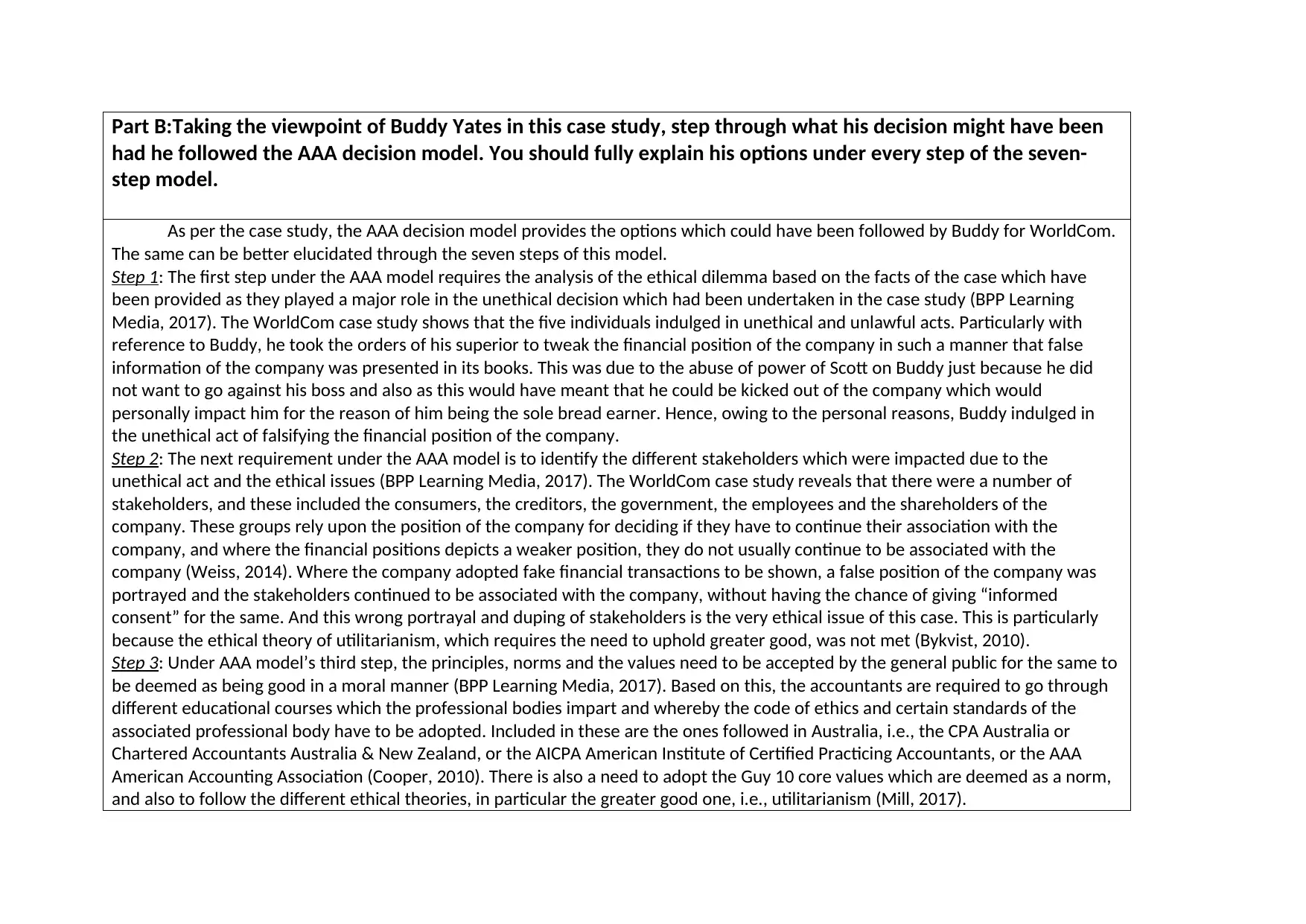
Part B:Taking the viewpoint of Buddy Yates in this case study, step through what his decision might have been
had he followed the AAA decision model. You should fully explain his options under every step of the seven-
step model.
As per the case study, the AAA decision model provides the options which could have been followed by Buddy for WorldCom.
The same can be better elucidated through the seven steps of this model.
Step 1: The first step under the AAA model requires the analysis of the ethical dilemma based on the facts of the case which have
been provided as they played a major role in the unethical decision which had been undertaken in the case study (BPP Learning
Media, 2017). The WorldCom case study shows that the five individuals indulged in unethical and unlawful acts. Particularly with
reference to Buddy, he took the orders of his superior to tweak the financial position of the company in such a manner that false
information of the company was presented in its books. This was due to the abuse of power of Scott on Buddy just because he did
not want to go against his boss and also as this would have meant that he could be kicked out of the company which would
personally impact him for the reason of him being the sole bread earner. Hence, owing to the personal reasons, Buddy indulged in
the unethical act of falsifying the financial position of the company.
Step 2: The next requirement under the AAA model is to identify the different stakeholders which were impacted due to the
unethical act and the ethical issues (BPP Learning Media, 2017). The WorldCom case study reveals that there were a number of
stakeholders, and these included the consumers, the creditors, the government, the employees and the shareholders of the
company. These groups rely upon the position of the company for deciding if they have to continue their association with the
company, and where the financial positions depicts a weaker position, they do not usually continue to be associated with the
company (Weiss, 2014). Where the company adopted fake financial transactions to be shown, a false position of the company was
portrayed and the stakeholders continued to be associated with the company, without having the chance of giving “informed
consent” for the same. And this wrong portrayal and duping of stakeholders is the very ethical issue of this case. This is particularly
because the ethical theory of utilitarianism, which requires the need to uphold greater good, was not met (Bykvist, 2010).
Step 3: Under AAA model’s third step, the principles, norms and the values need to be accepted by the general public for the same to
be deemed as being good in a moral manner (BPP Learning Media, 2017). Based on this, the accountants are required to go through
different educational courses which the professional bodies impart and whereby the code of ethics and certain standards of the
associated professional body have to be adopted. Included in these are the ones followed in Australia, i.e., the CPA Australia or
Chartered Accountants Australia & New Zealand, or the AICPA American Institute of Certified Practicing Accountants, or the AAA
American Accounting Association (Cooper, 2010). There is also a need to adopt the Guy 10 core values which are deemed as a norm,
and also to follow the different ethical theories, in particular the greater good one, i.e., utilitarianism (Mill, 2017).
had he followed the AAA decision model. You should fully explain his options under every step of the seven-
step model.
As per the case study, the AAA decision model provides the options which could have been followed by Buddy for WorldCom.
The same can be better elucidated through the seven steps of this model.
Step 1: The first step under the AAA model requires the analysis of the ethical dilemma based on the facts of the case which have
been provided as they played a major role in the unethical decision which had been undertaken in the case study (BPP Learning
Media, 2017). The WorldCom case study shows that the five individuals indulged in unethical and unlawful acts. Particularly with
reference to Buddy, he took the orders of his superior to tweak the financial position of the company in such a manner that false
information of the company was presented in its books. This was due to the abuse of power of Scott on Buddy just because he did
not want to go against his boss and also as this would have meant that he could be kicked out of the company which would
personally impact him for the reason of him being the sole bread earner. Hence, owing to the personal reasons, Buddy indulged in
the unethical act of falsifying the financial position of the company.
Step 2: The next requirement under the AAA model is to identify the different stakeholders which were impacted due to the
unethical act and the ethical issues (BPP Learning Media, 2017). The WorldCom case study reveals that there were a number of
stakeholders, and these included the consumers, the creditors, the government, the employees and the shareholders of the
company. These groups rely upon the position of the company for deciding if they have to continue their association with the
company, and where the financial positions depicts a weaker position, they do not usually continue to be associated with the
company (Weiss, 2014). Where the company adopted fake financial transactions to be shown, a false position of the company was
portrayed and the stakeholders continued to be associated with the company, without having the chance of giving “informed
consent” for the same. And this wrong portrayal and duping of stakeholders is the very ethical issue of this case. This is particularly
because the ethical theory of utilitarianism, which requires the need to uphold greater good, was not met (Bykvist, 2010).
Step 3: Under AAA model’s third step, the principles, norms and the values need to be accepted by the general public for the same to
be deemed as being good in a moral manner (BPP Learning Media, 2017). Based on this, the accountants are required to go through
different educational courses which the professional bodies impart and whereby the code of ethics and certain standards of the
associated professional body have to be adopted. Included in these are the ones followed in Australia, i.e., the CPA Australia or
Chartered Accountants Australia & New Zealand, or the AICPA American Institute of Certified Practicing Accountants, or the AAA
American Accounting Association (Cooper, 2010). There is also a need to adopt the Guy 10 core values which are deemed as a norm,
and also to follow the different ethical theories, in particular the greater good one, i.e., utilitarianism (Mill, 2017).
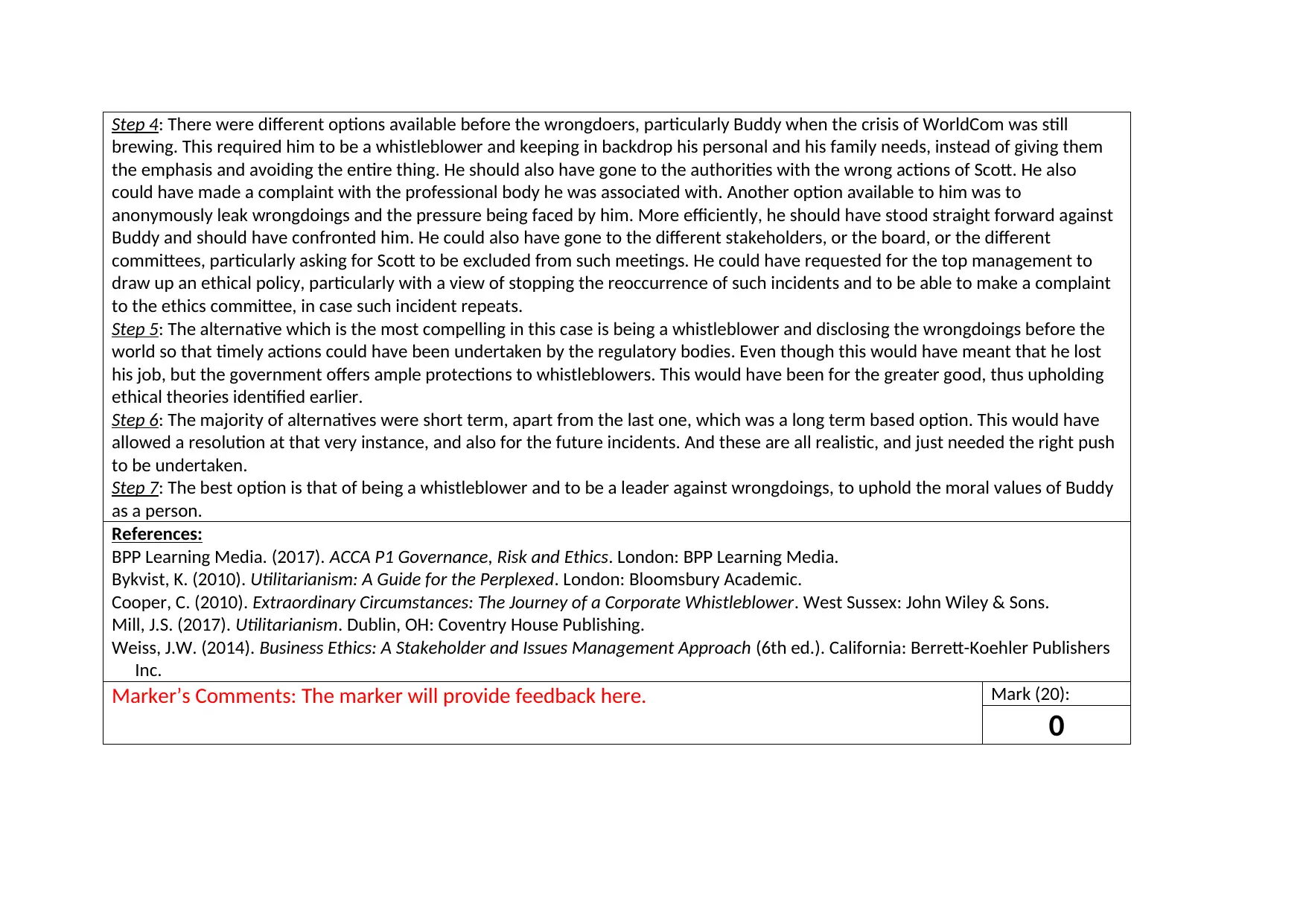
Step 4: There were different options available before the wrongdoers, particularly Buddy when the crisis of WorldCom was still
brewing. This required him to be a whistleblower and keeping in backdrop his personal and his family needs, instead of giving them
the emphasis and avoiding the entire thing. He should also have gone to the authorities with the wrong actions of Scott. He also
could have made a complaint with the professional body he was associated with. Another option available to him was to
anonymously leak wrongdoings and the pressure being faced by him. More efficiently, he should have stood straight forward against
Buddy and should have confronted him. He could also have gone to the different stakeholders, or the board, or the different
committees, particularly asking for Scott to be excluded from such meetings. He could have requested for the top management to
draw up an ethical policy, particularly with a view of stopping the reoccurrence of such incidents and to be able to make a complaint
to the ethics committee, in case such incident repeats.
Step 5: The alternative which is the most compelling in this case is being a whistleblower and disclosing the wrongdoings before the
world so that timely actions could have been undertaken by the regulatory bodies. Even though this would have meant that he lost
his job, but the government offers ample protections to whistleblowers. This would have been for the greater good, thus upholding
ethical theories identified earlier.
Step 6: The majority of alternatives were short term, apart from the last one, which was a long term based option. This would have
allowed a resolution at that very instance, and also for the future incidents. And these are all realistic, and just needed the right push
to be undertaken.
Step 7: The best option is that of being a whistleblower and to be a leader against wrongdoings, to uphold the moral values of Buddy
as a person.
References:
BPP Learning Media. (2017). ACCA P1 Governance, Risk and Ethics. London: BPP Learning Media.
Bykvist, K. (2010). Utilitarianism: A Guide for the Perplexed. London: Bloomsbury Academic.
Cooper, C. (2010). Extraordinary Circumstances: The Journey of a Corporate Whistleblower. West Sussex: John Wiley & Sons.
Mill, J.S. (2017). Utilitarianism. Dublin, OH: Coventry House Publishing.
Weiss, J.W. (2014). Business Ethics: A Stakeholder and Issues Management Approach (6th ed.). California: Berrett-Koehler Publishers
Inc.
Marker’s Comments: The marker will provide feedback here. Mark (20):
0
brewing. This required him to be a whistleblower and keeping in backdrop his personal and his family needs, instead of giving them
the emphasis and avoiding the entire thing. He should also have gone to the authorities with the wrong actions of Scott. He also
could have made a complaint with the professional body he was associated with. Another option available to him was to
anonymously leak wrongdoings and the pressure being faced by him. More efficiently, he should have stood straight forward against
Buddy and should have confronted him. He could also have gone to the different stakeholders, or the board, or the different
committees, particularly asking for Scott to be excluded from such meetings. He could have requested for the top management to
draw up an ethical policy, particularly with a view of stopping the reoccurrence of such incidents and to be able to make a complaint
to the ethics committee, in case such incident repeats.
Step 5: The alternative which is the most compelling in this case is being a whistleblower and disclosing the wrongdoings before the
world so that timely actions could have been undertaken by the regulatory bodies. Even though this would have meant that he lost
his job, but the government offers ample protections to whistleblowers. This would have been for the greater good, thus upholding
ethical theories identified earlier.
Step 6: The majority of alternatives were short term, apart from the last one, which was a long term based option. This would have
allowed a resolution at that very instance, and also for the future incidents. And these are all realistic, and just needed the right push
to be undertaken.
Step 7: The best option is that of being a whistleblower and to be a leader against wrongdoings, to uphold the moral values of Buddy
as a person.
References:
BPP Learning Media. (2017). ACCA P1 Governance, Risk and Ethics. London: BPP Learning Media.
Bykvist, K. (2010). Utilitarianism: A Guide for the Perplexed. London: Bloomsbury Academic.
Cooper, C. (2010). Extraordinary Circumstances: The Journey of a Corporate Whistleblower. West Sussex: John Wiley & Sons.
Mill, J.S. (2017). Utilitarianism. Dublin, OH: Coventry House Publishing.
Weiss, J.W. (2014). Business Ethics: A Stakeholder and Issues Management Approach (6th ed.). California: Berrett-Koehler Publishers
Inc.
Marker’s Comments: The marker will provide feedback here. Mark (20):
0
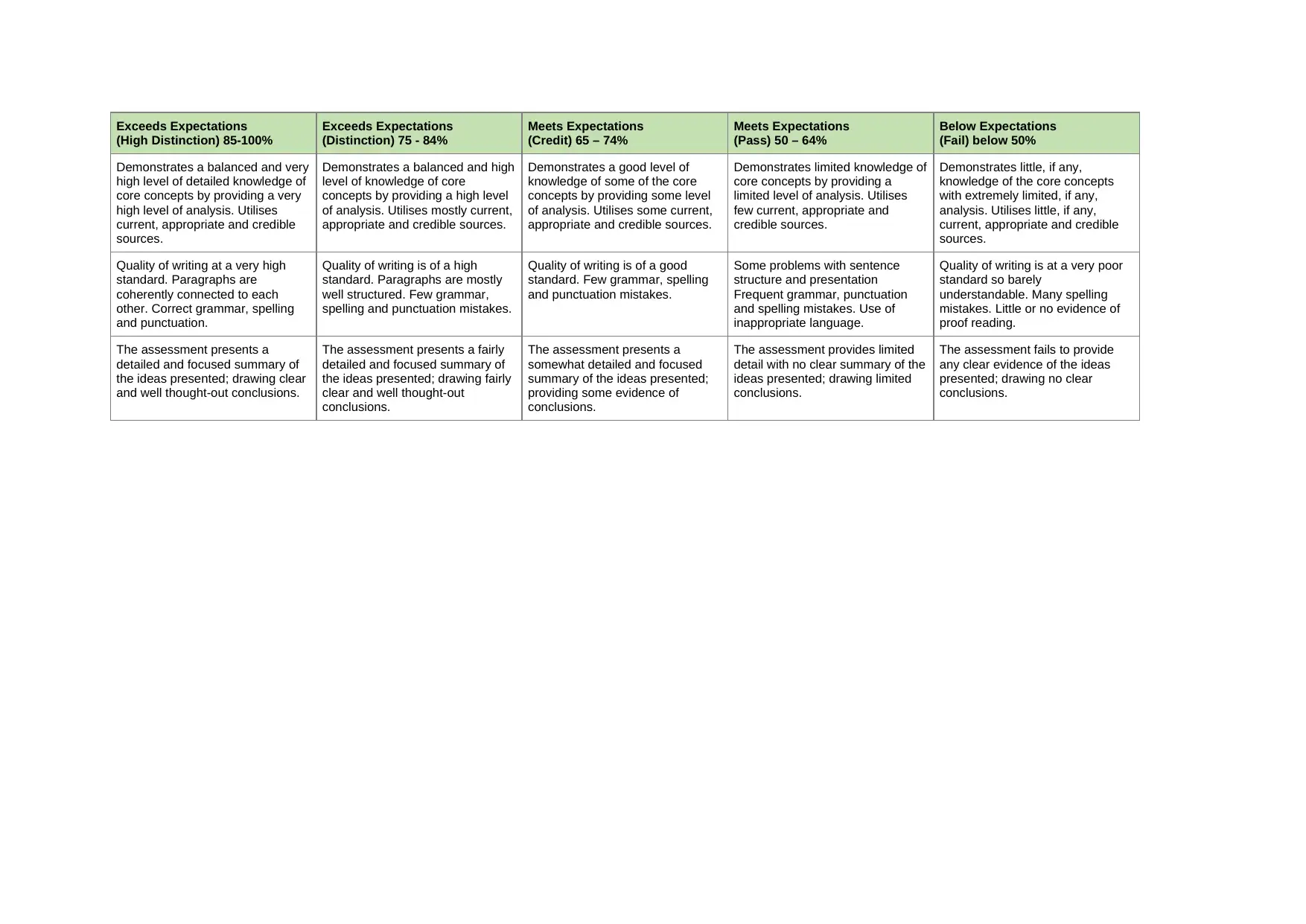
Exceeds Expectations
(High Distinction) 85-100%
Exceeds Expectations
(Distinction) 75 - 84%
Meets Expectations
(Credit) 65 – 74%
Meets Expectations
(Pass) 50 – 64%
Below Expectations
(Fail) below 50%
Demonstrates a balanced and very
high level of detailed knowledge of
core concepts by providing a very
high level of analysis. Utilises
current, appropriate and credible
sources.
Demonstrates a balanced and high
level of knowledge of core
concepts by providing a high level
of analysis. Utilises mostly current,
appropriate and credible sources.
Demonstrates a good level of
knowledge of some of the core
concepts by providing some level
of analysis. Utilises some current,
appropriate and credible sources.
Demonstrates limited knowledge of
core concepts by providing a
limited level of analysis. Utilises
few current, appropriate and
credible sources.
Demonstrates little, if any,
knowledge of the core concepts
with extremely limited, if any,
analysis. Utilises little, if any,
current, appropriate and credible
sources.
Quality of writing at a very high
standard. Paragraphs are
coherently connected to each
other. Correct grammar, spelling
and punctuation.
Quality of writing is of a high
standard. Paragraphs are mostly
well structured. Few grammar,
spelling and punctuation mistakes.
Quality of writing is of a good
standard. Few grammar, spelling
and punctuation mistakes.
Some problems with sentence
structure and presentation
Frequent grammar, punctuation
and spelling mistakes. Use of
inappropriate language.
Quality of writing is at a very poor
standard so barely
understandable. Many spelling
mistakes. Little or no evidence of
proof reading.
The assessment presents a
detailed and focused summary of
the ideas presented; drawing clear
and well thought-out conclusions.
The assessment presents a fairly
detailed and focused summary of
the ideas presented; drawing fairly
clear and well thought-out
conclusions.
The assessment presents a
somewhat detailed and focused
summary of the ideas presented;
providing some evidence of
conclusions.
The assessment provides limited
detail with no clear summary of the
ideas presented; drawing limited
conclusions.
The assessment fails to provide
any clear evidence of the ideas
presented; drawing no clear
conclusions.
(High Distinction) 85-100%
Exceeds Expectations
(Distinction) 75 - 84%
Meets Expectations
(Credit) 65 – 74%
Meets Expectations
(Pass) 50 – 64%
Below Expectations
(Fail) below 50%
Demonstrates a balanced and very
high level of detailed knowledge of
core concepts by providing a very
high level of analysis. Utilises
current, appropriate and credible
sources.
Demonstrates a balanced and high
level of knowledge of core
concepts by providing a high level
of analysis. Utilises mostly current,
appropriate and credible sources.
Demonstrates a good level of
knowledge of some of the core
concepts by providing some level
of analysis. Utilises some current,
appropriate and credible sources.
Demonstrates limited knowledge of
core concepts by providing a
limited level of analysis. Utilises
few current, appropriate and
credible sources.
Demonstrates little, if any,
knowledge of the core concepts
with extremely limited, if any,
analysis. Utilises little, if any,
current, appropriate and credible
sources.
Quality of writing at a very high
standard. Paragraphs are
coherently connected to each
other. Correct grammar, spelling
and punctuation.
Quality of writing is of a high
standard. Paragraphs are mostly
well structured. Few grammar,
spelling and punctuation mistakes.
Quality of writing is of a good
standard. Few grammar, spelling
and punctuation mistakes.
Some problems with sentence
structure and presentation
Frequent grammar, punctuation
and spelling mistakes. Use of
inappropriate language.
Quality of writing is at a very poor
standard so barely
understandable. Many spelling
mistakes. Little or no evidence of
proof reading.
The assessment presents a
detailed and focused summary of
the ideas presented; drawing clear
and well thought-out conclusions.
The assessment presents a fairly
detailed and focused summary of
the ideas presented; drawing fairly
clear and well thought-out
conclusions.
The assessment presents a
somewhat detailed and focused
summary of the ideas presented;
providing some evidence of
conclusions.
The assessment provides limited
detail with no clear summary of the
ideas presented; drawing limited
conclusions.
The assessment fails to provide
any clear evidence of the ideas
presented; drawing no clear
conclusions.
1 out of 13
Your All-in-One AI-Powered Toolkit for Academic Success.
+13062052269
info@desklib.com
Available 24*7 on WhatsApp / Email
![[object Object]](/_next/static/media/star-bottom.7253800d.svg)
Unlock your academic potential
© 2024 | Zucol Services PVT LTD | All rights reserved.


